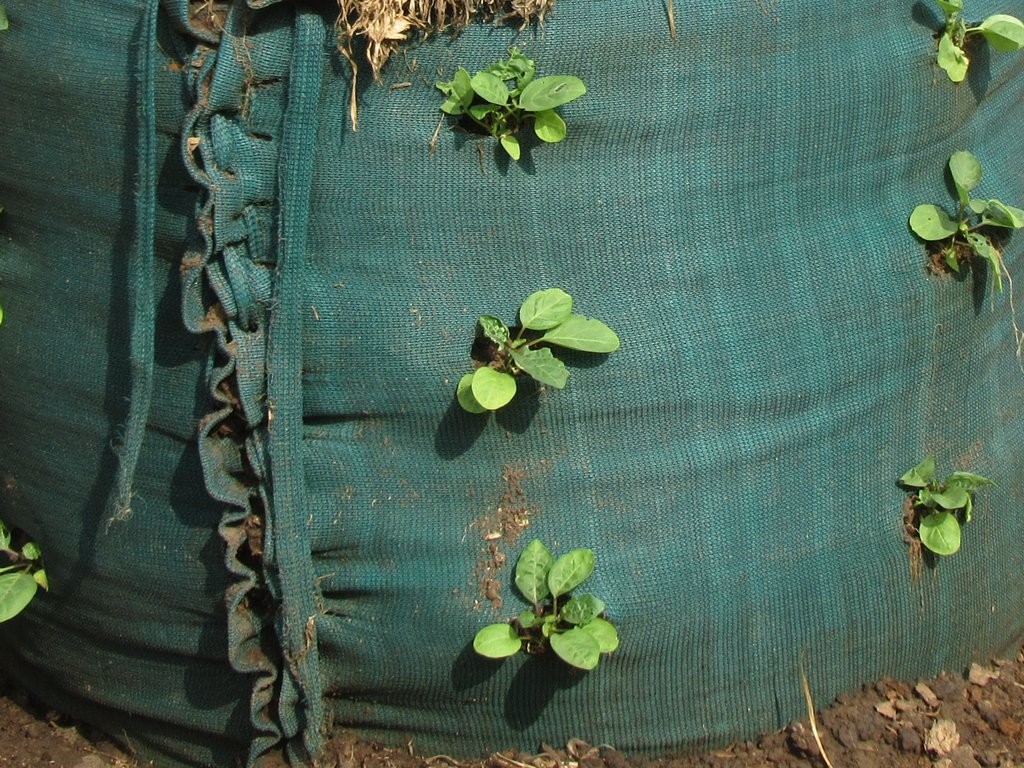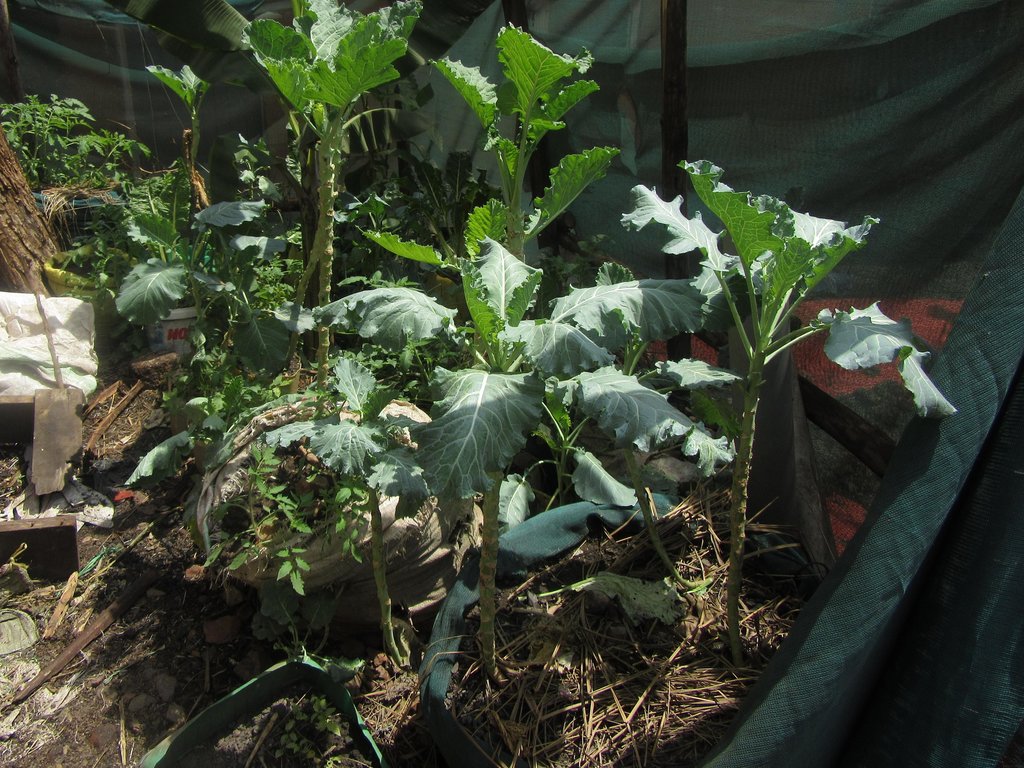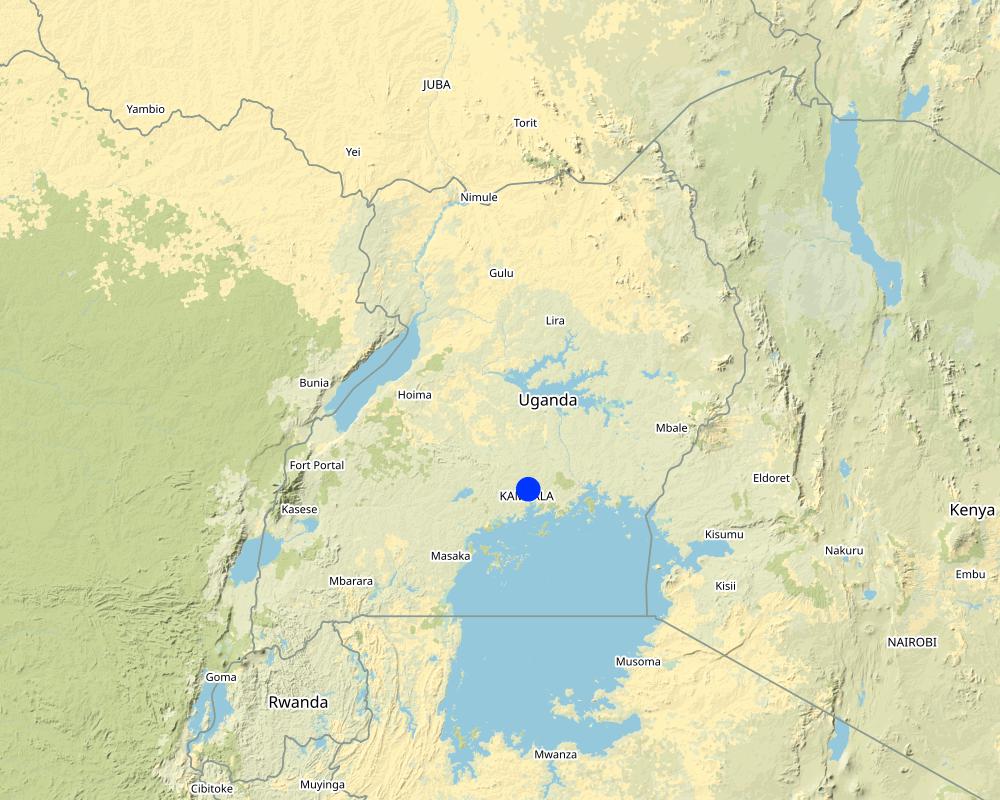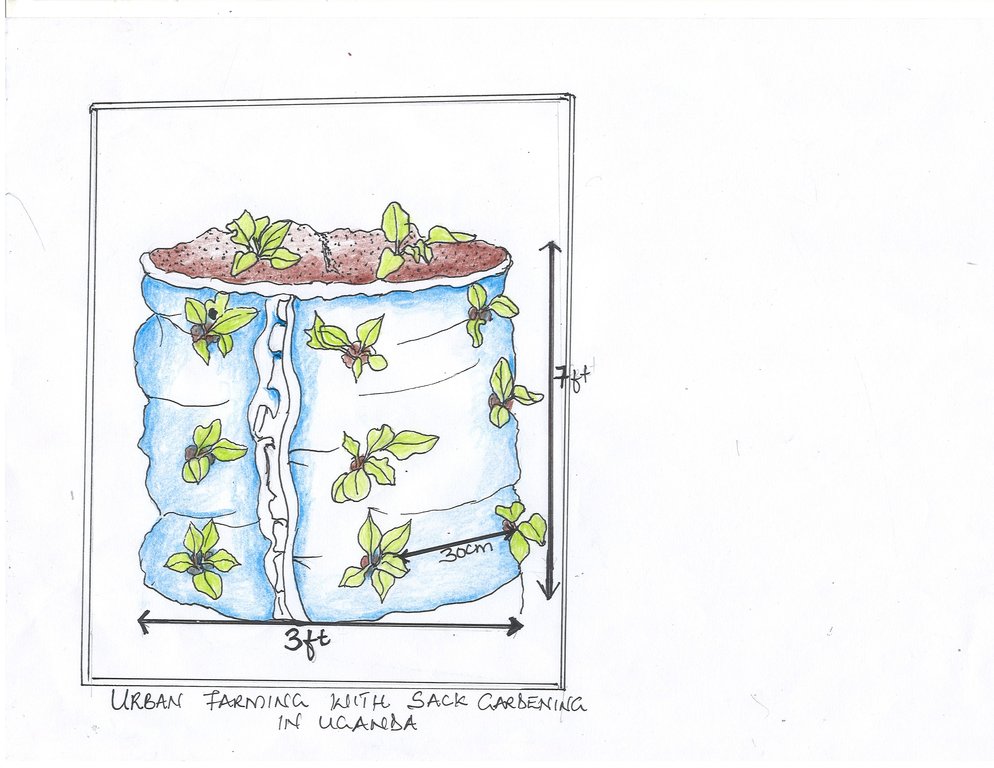Urban farming with sack gardening [Uganda]
- Creation:
- Update:
- Compiler: Babirye Irene
- Editors: Jalia Namakula, Kamugisha Rick Nelson
- Reviewers: Nicole Harari, Udo Höggel
Okulimila mu kutiya
technologies_3452 - Uganda
View sections
Expand all Collapse all1. General information
1.2 Contact details of resource persons and institutions involved in the assessment and documentation of the Technology
Key resource person(s)
land user:
Komuhangi Grace
+256758581024
NARO
Kamonkya 2, kisenyi 2 zone Kampala District.
Uganda
Name of project which facilitated the documentation/ evaluation of the Technology (if relevant)
Scaling-up SLM practices by smallholder farmers (IFAD)Name of the institution(s) which facilitated the documentation/ evaluation of the Technology (if relevant)
National Agricultural Research Organisation (NARO) - Uganda1.3 Conditions regarding the use of data documented through WOCAT
When were the data compiled (in the field)?
01/29/2018
The compiler and key resource person(s) accept the conditions regarding the use of data documented through WOCAT:
Ja
1.4 Declaration on sustainability of the described Technology
Is the Technology described here problematic with regard to land degradation, so that it cannot be declared a sustainable land management technology?
Nee
Comments:
The approach is seen as a cheap and healthy solution to food insecurity, its easy to establish on a very small scale.
2. Description of the SLM Technology
2.1 Short description of the Technology
Definition of the Technology:
Sack gardening is a technology that consists of a series of sacks that are filled with manure, soil and small stones that enable water to drain, from the tops and sides of the sacks, often referred to as multi-stoney gardens to increase production.
2.2 Detailed description of the Technology
Description:
The technology is mostly promoted by farmers in Kampala District, Central Uganda and other parts of the country. The technology is seen as a cheap and healthy solution to food insecurity and runaway unemployment in Kampala’s slum. It is preferred by farmers because it's cheap, high-yielding and promoting food security while maximizing land and water use.
This technology is practiced in the slum area of Kisenyi 2 zone, Kamokya parish, Kampala District and was established in 2015, where the farmer got farming training from Kampala City Council Authority through demonstrations in the urban farming program. The main reasons for its establishment were; the ease to establishment and management, space optimization, no special skills required and affordability.
To establish such a technology the farmer started by collecting huge sacks of banana leaves that had been dumped around the neighborhood.
Black soil was mixed with chicken manure that was available. Small pebble stones were added and strong sticks placed in the middle of the sack, right from bottom to top. The sack was then filled with soil, leaving the stones erect in the middle. For an optimal production, the farmer used bags with a containing capacity of 50 to 100 kilograms. Additonal items were one polyethylene (food-safe bag. ie: rice bag) and a pipe of the height of the bag, opened at both ends, 15 to 20cm long.
The complete system consists of 50 kilos of soil, 25 kilos of fertilizer (compost, manure) which is adjusted according to the
quality of the soil plus 15 kilos of stones (3 to 7 cm diameter).
In some sacks the farmer grows tomatoes, cabbages and carrots. Usually the crops with big roots, like carrots, go on the top, and the sides are reserved for cabbages with small roots, she says. The sack garden is watered on a daily basis, twice a day if the weather is dry and once a day if the weather is humid. There is no such a thing as a crop-growing season. The garden is ever green, even during the dry season. The farmer makes 0.6$ selling spinach to neighbors, and 0.84$ selling produce to the market. This translates to about 27.8$ per month, after deducting expenses.
Sack gardening is very advantageous to the farmer and other farmers are trained in the technology by the farmer who started it. The farmer receives an equivalent of 1.39$ a day. For 20 training days this totals to 27.8$ a month from tutoring a women group in Kamokya. This additonal income helps the farmer securing enough money to meet needs like school fees, food and utility payments. It also provides a secure source of nutritional food, facilitates growing of vegetables in areas without suitable soils or adequate space, promotes efficient and effective utilization of available water and nutrients.
2.3 Photos of the Technology
2.4 Videos of the Technology
Comments, short description:
Video of sack gardening.
Date:
22/3/2018
Location:
Kamonkya village , Kampala District
Name of videographer:
Irene Babirye
2.5 Country/ region/ locations where the Technology has been applied and which are covered by this assessment
Country:
Uganda
Region/ State/ Province:
Central Region
Map
×2.6 Date of implementation
Indicate year of implementation:
2016
2.7 Introduction of the Technology
Specify how the Technology was introduced:
- during experiments/ research
Comments (type of project, etc.):
Through urban farming demonstrations .
3. Classification of the SLM Technology
3.1 Main purpose(s) of the Technology
- improve production
- create beneficial economic impact
- create beneficial social impact
3.2 Current land use type(s) where the Technology is applied

Cropland
- Annual cropping
Main crops (cash and food crops):
Tomatoes, cabbages, sukuma wiki and cabbages.
Comments:
The farmer has several sacks with different vegetables.
3.3 Further information about land use
Water supply for the land on which the Technology is applied:
- mixed rainfed-irrigated
Number of growing seasons per year:
- 1
Specify:
The technology is established/grown once and harvested through the year.
3.4 SLM group to which the Technology belongs
- minimal soil disturbance
- home gardens
3.5 Spread of the Technology
Specify the spread of the Technology:
- applied at specific points/ concentrated on a small area
3.6 SLM measures comprising the Technology

agronomic measures
- A2: Organic matter/ soil fertility
- A5: Seed management, improved varieties
3.7 Main types of land degradation addressed by the Technology

soil erosion by water
- Wt: loss of topsoil/ surface erosion

biological degradation
- Bc: reduction of vegetation cover
3.8 Prevention, reduction, or restoration of land degradation
Specify the goal of the Technology with regard to land degradation:
- not applicable
4. Technical specifications, implementation activities, inputs, and costs
4.1 Technical drawing of the Technology
4.2 Technical specifications/ explanations of technical drawing
The sack is vertical with 10-15 cm.
Vegetables planted include Carrots, Tomatoes and Sukuma wikki
4.3 General information regarding the calculation of inputs and costs
Specify how costs and inputs were calculated:
- per Technology unit
Specify currency used for cost calculations:
- US Dollars
Indicate exchange rate from USD to local currency (if relevant): 1 USD =:
3600.0
Indicate average wage cost of hired labour per day:
2.78$
4.4 Establishment activities
| Activity | Type of measure | Timing | |
|---|---|---|---|
| 1. | Clearing a nursery bed | Management | 1 day |
| 2. | Planting the seeds in the nursery bed | 1 day | |
| 3. | Mixing compost manure with soil | 1 day | |
| 4. | Buying the bags | Management | 1 day |
| 5. | Filling the sack with soil, sticks and stones | 1 day | |
| 6. | Transplanting | 3 days | |
| 7. | Harvesting | Once a week | |
| 8. | Spraying | Daily |
4.5 Costs and inputs needed for establishment
| Specify input | Unit | Quantity | Costs per Unit | Total costs per input | % of costs borne by land users | |
|---|---|---|---|---|---|---|
| Labour | Sack fiiling | Man day | 5.0 | 1.39 | 6.95 | 100.0 |
| Labour | Nursery bed preparation | Man day | 2.0 | 1.39 | 2.78 | 100.0 |
| Labour | Transplanting | Man day | 5.0 | 1.39 | 6.95 | 100.0 |
| Labour | spraying | Man day | 1.0 | 1.39 | 1.39 | 100.0 |
| Equipment | Hoes | Pieces | 2.0 | 2.78 | 5.56 | 100.0 |
| Equipment | Wheelbarrow | Piece | 1.0 | 27.78 | 27.78 | 100.0 |
| Equipment | Sprayer pump | Piece | 1.0 | 13.89 | 13.89 | 100.0 |
| Equipment | Sacks | Pack | 10.0 | 4.167 | 41.67 | 100.0 |
| Plant material | Tomato seeds | kg | 1.0 | 1.95 | 1.95 | 100.0 |
| Plant material | Cabbage seeds | kg | 1.0 | 1.95 | 1.95 | 100.0 |
| Plant material | Carrots seeds | kg | 1.0 | 2.3 | 2.3 | 100.0 |
| Plant material | Sukuma wiki seeds | kg | 1.0 | 1.95 | 1.95 | 100.0 |
| Fertilizers and biocides | Compost manure | Bags | 12.0 | 1.95 | 23.4 | 100.0 |
| Fertilizers and biocides | Dythene pestcides | kg | 1.0 | 6.95 | 6.95 | 100.0 |
| Fertilizers and biocides | Dudu cyper pestcides | litre | 1.0 | 2.78 | 2.78 | 100.0 |
| Construction material | Stones | Trip | 0.5 | 8.34 | 4.17 | 100.0 |
| Total costs for establishment of the Technology | 152.42 | |||||
Comments:
The farmer had ready capital to establish the technology
4.6 Maintenance/ recurrent activities
| Activity | Type of measure | Timing/ frequency | |
|---|---|---|---|
| 1. | Watering | Management | Everyday |
| 2. | Spraying | Management | Once in two weeks |
| 3. | Weeding | Management | Once a week |
| 4. | Harvesting | Management | Every day |
Comments:
The farmer does all the maintenance activities. There are no costs.
4.7 Costs and inputs needed for maintenance/ recurrent activities (per year)
| Specify input | Unit | Quantity | Costs per Unit | Total costs per input | % of costs borne by land users | |
|---|---|---|---|---|---|---|
| Labour | Harvesting | Man day | 0.5 | 2.7 | 1.35 | 100.0 |
| Labour | Weeding | Man day | 0.5 | 2.7 | 1.35 | 100.0 |
| Fertilizers and biocides | Dithane pestcides | kg | 1.0 | 7.0 | 7.0 | 100.0 |
| Fertilizers and biocides | Dudu cyper pestcides | litre | 1.0 | 2.7 | 2.7 | 100.0 |
| Total costs for maintenance of the Technology | 12.4 | |||||
4.8 Most important factors affecting the costs
Describe the most determinate factors affecting the costs:
Pestcides costs affect the technology.
5. Natural and human environment
5.1 Climate
Annual rainfall
- < 250 mm
- 251-500 mm
- 501-750 mm
- 751-1,000 mm
- 1,001-1,500 mm
- 1,501-2,000 mm
- 2,001-3,000 mm
- 3,001-4,000 mm
- > 4,000 mm
Agro-climatic zone
- humid
5.2 Topography
Slopes on average:
- flat (0-2%)
- gentle (3-5%)
- moderate (6-10%)
- rolling (11-15%)
- hilly (16-30%)
- steep (31-60%)
- very steep (>60%)
Landforms:
- plateau/plains
- ridges
- mountain slopes
- hill slopes
- footslopes
- valley floors
Altitudinal zone:
- 0-100 m a.s.l.
- 101-500 m a.s.l.
- 501-1,000 m a.s.l.
- 1,001-1,500 m a.s.l.
- 1,501-2,000 m a.s.l.
- 2,001-2,500 m a.s.l.
- 2,501-3,000 m a.s.l.
- 3,001-4,000 m a.s.l.
- > 4,000 m a.s.l.
Indicate if the Technology is specifically applied in:
- not relevant
5.3 Soils
Soil depth on average:
- very shallow (0-20 cm)
- shallow (21-50 cm)
- moderately deep (51-80 cm)
- deep (81-120 cm)
- very deep (> 120 cm)
Soil texture (topsoil):
- medium (loamy, silty)
Soil texture (> 20 cm below surface):
- medium (loamy, silty)
Topsoil organic matter:
- medium (1-3%)
5.4 Water availability and quality
Ground water table:
> 50 m
Availability of surface water:
good
Water quality (untreated):
good drinking water
Is water salinity a problem?
Nee
Is flooding of the area occurring?
Nee
Comments and further specifications on water quality and quantity:
The farmer taps National Water, which provides good clean water.
5.5 Biodiversity
Species diversity:
- medium
Habitat diversity:
- low
5.6 Characteristics of land users applying the Technology
other (specify):
Urban setting
Market orientation of production system:
- mixed (subsistence/ commercial
Off-farm income:
- less than 10% of all income
Relative level of wealth:
- average
Individuals or groups:
- individual/ household
Level of mechanization:
- manual work
Gender:
- women
Age of land users:
- middle-aged
Indicate other relevant characteristics of the land users:
She's a married woman with five children.
5.7 Average area of land owned or leased by land users applying the Technology
- < 0.5 ha
- 0.5-1 ha
- 1-2 ha
- 2-5 ha
- 5-15 ha
- 15-50 ha
- 50-100 ha
- 100-500 ha
- 500-1,000 ha
- 1,000-10,000 ha
- > 10,000 ha
Is this considered small-, medium- or large-scale (referring to local context)?
- small-scale
Comments:
The technology is practiced at home.
5.8 Land ownership, land use rights, and water use rights
- Urban slum
Land use rights:
- open access (unorganized)
Water use rights:
- communal (organized)
5.9 Access to services and infrastructure
health:
- poor
- moderate
- good
education:
- poor
- moderate
- good
technical assistance:
- poor
- moderate
- good
employment (e.g. off-farm):
- poor
- moderate
- good
markets:
- poor
- moderate
- good
energy:
- poor
- moderate
- good
roads and transport:
- poor
- moderate
- good
drinking water and sanitation:
- poor
- moderate
- good
financial services:
- poor
- moderate
- good
6. Impacts and concluding statements
6.1 On-site impacts the Technology has shown
Socio-economic impacts
Production
crop production
Quantity before SLM:
Had 2 sacks
Quantity after SLM:
She has 10 sacks
Comments/ specify:
The farmer acquired skills in sustainable sack garnening
crop quality
Quantity before SLM:
Vegetable quality were vere low
Quantity after SLM:
Improved quality
Comments/ specify:
She maintains the garden on a daily basis
risk of production failure
Quantity before SLM:
She didnot spray the plants
Quantity after SLM:
Sprays the plants as directed
Comments/ specify:
The farmer has enough skills in sack gardening
Income and costs
expenses on agricultural inputs
Comments/ specify:
She use compost manure
farm income
Quantity before SLM:
She used to 0.6$ day
Quantity after SLM:
She gets 0.84$ a day
Comments/ specify:
Reduced maintenance costs and high yields
Socio-cultural impacts
food security/ self-sufficiency
Quantity before SLM:
Vegetables were bought from the market
Quantity after SLM:
Vegetables are harvested and sold to the market
Ecological impacts
Soil
soil loss
Comments/ specify:
This sack based technology reduces the need to establish vegetable gardening on open ground thus reduces the risk of soil losses
6.3 Exposure and sensitivity of the Technology to gradual climate change and climate-related extremes/ disasters (as perceived by land users)
Gradual climate change
Gradual climate change
| Season | Type of climatic change/ extreme | How does the Technology cope with it? | |
|---|---|---|---|
| annual temperature | decrease | moderately | |
| seasonal temperature | wet/ rainy season | decrease | moderately |
Climate-related extremes (disasters)
Biological disasters
| How does the Technology cope with it? | |
|---|---|
| insect/ worm infestation | not well |
6.4 Cost-benefit analysis
How do the benefits compare with the establishment costs (from land users’ perspective)?
Short-term returns:
positive
Long-term returns:
very positive
How do the benefits compare with the maintenance/ recurrent costs (from land users' perspective)?
Short-term returns:
very positive
Long-term returns:
very positive
Comments:
She doesn't spend too much on maintenance since she does all the activities by her self.
6.5 Adoption of the Technology
- 1-10%
If available, quantify (no. of households and/ or area covered):
4
Of all those who have adopted the Technology, how many have did so spontaneously, i.e. without receiving any material incentives/ payments?
- 90-100%
Comments:
All cost borne by producer
6.6 Adaptation
Has the Technology been modified recently to adapt to changing conditions?
Nee
6.7 Strengths/ advantages/ opportunities of the Technology
| Strengths/ advantages/ opportunities in the land user’s view |
|---|
| Its a source of fresh greens and income. |
| It is very cheap to establish and maintain. |
| It allows many plants to grow from the same sack |
| Strengths/ advantages/ opportunities in the compiler’s or other key resource person’s view |
|---|
| The technology is not labor demanding since the farmer does all the activities. |
| It motivates people to adopt it. |
| Optimal utilization of the land. |
6.8 Weaknesses/ disadvantages/ risks of the Technology and ways of overcoming them
| Weaknesses/ disadvantages/ risks in the land user’s view | How can they be overcome? |
|---|---|
| The technology is relatively expensive to establish. | Start small for example a farmer should start with two sacks. |
| It requires ready market. | First get ready market before harvesting. |
| Weaknesses/ disadvantages/ risks in the compiler’s or other key resource person’s view | How can they be overcome? |
|---|---|
| The technology requires full time maintenance for example watering of the plants. | The farmer should be available to do all the maintenance activities. |
| It's well practiced in a home for security purposes. | If its not practiced at a home, a farmer should provide security of the garden. |
| Pests and diseases. | The farmer should spray as directed to prevent pests and diseases. |
7. References and links
7.1 Methods/ sources of information
- field visits, field surveys
1
- interviews with land users
1
- interviews with SLM specialists/ experts
1
- compilation from reports and other existing documentation
1
Links and modules
Expand all Collapse allLinks
No links
Modules
No modules






